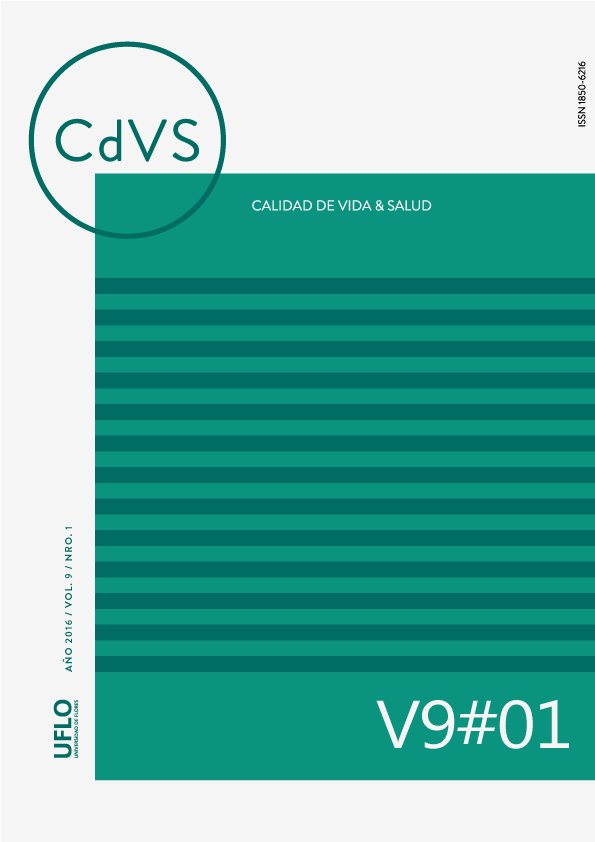Relationship between physical activity and academic performance in adolescents School.
Keywords:
Physical activity, academic performance, self-concept and self-esteem.Abstract
It seems that physical activity practiced regularly brings great benefits to the health of adolescents. The present work had like aim study the existent relations between the practice of physical activity, the academic performance, the self-concept (academic, social, emotional, familiar and physicist) and the self-esteem of the teenagers given the importance that according to the literature has the physical exercise on these variables. For such end worked with a sample of teenagers (N=98) of different sex and age. The results indicate a correlation inversely proportional, significant (p< .001) and drop (r= -,38) between the physical activity and the qualifications of the students and directly proportional but no significant with the rest of variables to exception of the self-concept academic that yes is significant (p< .05) with a low intensity (r= .21). Results seem to contradict, at least partially, to what has come with regard to the relation between the practice of physical activity and the academic performance, but yes seem to be congruent regarding the improvement of the self-concept.
References
Aberg, M. A. I., Pedersen, N. L., Torén, K., Svartengren, M., Bäckstrand, B., Johnsson, T., Kuhn, H. G. (2009). Cardiovascular fitness is associated with cognition in young adulthood. Proceedings of the National Academy of Sciences of the United States of America, 106(49), 20906-20911.
Ardoy, D. N., Fernández-Rodríguez, J. M., Jiménez-Pavón, D., Castillo, R., Ruiz, J. R., & Ortega, F. B. (2014). A physical education trial improves adolescents’ cognitive performance and academic achievement: the EDUFIT study. Scandinavian Journal of Medicine & Science in Sports, 24(1), e52-61.
Aznar Laín, S., & Webster, T. (2006). Actividad física y salud en la infancia y la adolescencia. Guía para todas las personas que participan en su educación. Ministerio de Educación.
Becerro, M. (2003). La actividad física protege la función cognitiva y sensorial.
Beltrán-Carrillo, V. J., Devís-Devís, J., & Peiró-Velert, C. (2012). Actividad física y sedentarismo en adolescentes de la comunidad valenciana physical activity and sedentary behaviour in adolescents from valencian region.
Booth, J. N., Leary, S. D., Joinson, C., Ness, A. R., Tomporowski, P. D., Boyle, J. M., & Reilly, J. J. (2014). Associations between objectively measured physical activity and academic attainment in adolescents from a UK cohort. British Journal of Sports Medicine, 48(3), 265-270.
Bradley, J., Keane, F., & Crawford, S. (2013). School sport and academic achievement. The Journal of School Health, 83(1), 8-13.
Candel, N., Olmedilla, A., & Blas, A. (2008). Relaciones entre la práctica de actividad física y el autoconcepto, la ansiedad y la depresión en chicas adolescentes. Cuadernos de psicología del deporte, 8(1), 61-77.
Carreras-González, G., & Ordóñez-Llanos, J. (2007). Adolescencia, actividad física y factores metabólicos de riesgo cardiovascular. Revista Española de Cardiología, 60(6), 565-568.
Cascón, I. V. (2000). Análisis de las calificaciones escolares como criterio de rendimiento académico.
Chaddock, L., Erickson, K. I., Prakash, R. S., Kim, J. S., Voss, M. W., Vanpatter, M., Kramer, A. F. (2010). A neuroimaging investigation of the association between aerobic fitness, hippocampal volume, and memory performance in preadolescent children. Brain Research, 1358, 172-183.
Chillón, P. (2005). Efectos de un programa de intervención de educación física para la salud en adolescentes de 3° de ESO. Granada.
Clapés, G. (2006). Cómo evitar el fracaso escolar en secundaria: recursos. Narcea Ediciones.
Delgado, M., & Tercedor, P. (2002). Estrategias de intervención en educación para la salud desde la educación física. INDE.
Devís, J. (2000). Actividad física, deporte y salud (1a ed.). Barcelona: INDE.
EPA de España. (2015). EPA de España Paro entre 16 y 19 años 2015.
Esteban-Cornejo, I., Tejero-González, C. M., Martinez-Gomez, D., del-Campo, J., González-Galo, A., Padilla-Moledo, C., Veiga, O. L. (2014). Independent and Combined Influence of the Components of Physical Fitness on Academic Performance in Youth. The Journal of Pediatrics, 165(2), 306-312.e2.
Flöel, A., Ruscheweyh, R., Krüger, K., Willemer, C., Winter, B., Völker, K., … Knecht, S. (2010). Physical activity and memory functions: are neurotrophins and cerebral gray matter volume the missing link? NeuroImage, 49(3), 2756-2763.
Franchek, García, À., Roig, M., Gabaldó, S., Torralba, F., Cañada, D., Román, B. (2013). La actividad física mejora el aprendizaje y el rendimiento escolar Los beneficios del ejercicio en la salud integral del niño a nivel físico, mental y en la generación de valores. (p. 144). Esplugues de Llobregat (Barcelona): Hospital Sant Joan de Déu.
Garcia, A. W., Broda, M. A., Frenn, M., Coviak, C., Pender, N. J., & Ronis, D. L. (1995). Gender and developmental differences in exercise beliefs among youth and prediction of their exercise behavior. The Journal of School Health, 65(6), 213-219.
García, F., & Musitu, G. (1999). AF5: Autoconcepto forma 5 [AF5: Self-concept form 5] (Vol. 265). TEA Ediciones.
García Grau, P., Ayora, D., Calabuig, F., & Prado Gascó, V. J. (2014). Self-concept in preadolescence: A brief version of AF5 scale.
González, M. Á., & Alvariñas, M. (2004). Relación entre la práctica físico-deportivo extraescolar y el autoconcepto físico en la adolescencia. Revista de educación física: Renovar la teoría y práctica, (94), 5-8.
González, M. T. (1999). Algo sobre la autoestima. Qué es y cómo se expresa. Aula, 11(0).
Henao, G. C., Restrepo, J. A., & Tilano, L. M. (2009). Prácticas educativas familiares y desempeño académico en adolescentes escolarizados en el grado noveno de instituciones educativas oficiales del municipio de Envigado.
Janz, K. F., Dawson, J. D., & Mahoney, L. T. (2000). Tracking physical fitness and physical activity from childhood to adolescence: the Muscatine study. Medicine and science in sports and exercise, 32(7), 1250–1257.
Kleim, J. A., Cooper, N. R., & VandenBerg, P. M. (2002). Exercise induces angiogenesis but does not alter movement representations within rat motor cortex. Brain Research, 934(1), 1-6.
Lorenzana, por L. (2013). El autoconcepto y la autoestima.
Mantilla Toloza, S. C., & Gómez-Conesa, A. (2007). El Cuestionario Internacional de Actividad Física. Un instrumento adecuado en el seguimiento de la actividad física poblacional. Revista Iberoamericana de Fisioterapia y Kinesiología, 10(1), 48-52.
MEC. (2013). Datos y Cifras del curso escolar 2013-2014.
Morales, J. F. D., & López, M. P. S. (2002). Relaciones entre estilos de personalidad y satisfacción autopercibida en diferentes áreas vitales.
Moreno, J. A., Cervelló, E., & Moreno, R. (2008). Importancia de la práctica físico-deportiva y del género en el autoconcepto físico de los 9 a los 23 años. International Journal of Clinical and Health Psychology, 8(1), 171–183.
Moreno, J. A., Moreno, R., & Cervelló, E. (2013). El autoconcepto físico como predictor de la intención de ser físicamente activo. Psicología y Salud, 17(2), 261-267.
Moriana, J. A., Alós, F., Alcalá, R., Pino, M. J., Herruzo, J., & Ruiz, R. (2006). Actividades extraescolares y rendimiento académico en alumnos de educación secundaria (Extracurricular activities and academic performance in secondary students).
OMS | La actividad física en los jóvenes. (s. f.). Recuperado 19 de mayo de 2015, a partir de http://www.who.int/dietphysicalactivity/factsheet_young_people/es/
Oviedo, G., Sánchez, J., Castro, R., Calvo, M., Sevilla, J. C., Iglesias, A., & Guerra, M. (2013). Niveles de actividad física en población adolescente: estudio de caso. Retos: nuevas tendencias en educación física, deporte y recreación, (23), 43–47.
Pellicer-Chenoll, M., Garcia-Massó, X., Morales, J., Serra-Añó, P., Solana-Tramunt, M., González, L.-M., & Toca-Herrera, J.-L. (2015). Physical activity, physical fitness and academic achievement in adolescents: a self-organizing maps approach. Health Education Research, 30(3), 436-448.
Pérez Samaniego, V. (1999). El cambio de las actitudes hacia la actividad física relacionada con la salud: una investigación con estudiantes de Magisterio especialistas en Educación Física. Universitat de València.
Riddoch, C. J., Bo Andersen, L., Wedderkopp, N., Harro, M., Klasson-Heggebø, L., Sardinha, L. B., Ekelund, U. (2004). Physical Activity Levels and Patterns of 9- and 15-yr-Old European Children: Medicine & Science in Sports & Exercise, 36(1), 86-92.
Rosemberg, M. (1965). Society and the adolescent self-image. Princeton, NJ: Princeton University Press.
Sasco, A. J., Merrill, R. M., Benhaïm-Luzon, V., Gérard, J. P., & Freyer, G. (2003). Trends in tobacco smoking among adolescents in Lyon, France. European Journal of Cancer (Oxford, England: 1990), 39(4), 496-504.
Schinder, A. F., & Poo, M. (2000). The neurotrophin hypothesis for synaptic plasticity. Trends in Neurosciences, 23(12), 639-645.
Scudder, M. R., Federmeier, K. D., Raine, L. B., Direito, A., Boyd, J. K., & Hillman, C. H. (2014). The association between aerobic fitness and language processing in children: Implications for academic achievement. Brain and Cognition, 87, 140.
Tercedor, P. (2001). Actividad física, condición física y salud. Wanceulen Editorial Deportiva.
Thayer, R. E., Newman, J. R., & McClain, T. M. (1994). Self-regulation of mood: Strategies for changing a bad mood, raising energy, and reducing tension. Journal of Personality and Social Psychology, 67(5), 910-925.
Troiano, R. P., Berrigan, D., Dodd, K. W., Mâsse, L. C., Tilert, T., & McDowell, M. (2008). Physical activity in the United States measured by accelerometer. Medicine and Science in Sports and Exercise, 40(1), 181-188.
William, S., Stefano, A., & Suárez, G. R. (2004). El impacto de la actividad física y el deporte sobre la salud, la cognición, la socialización y el rendimiento académico: Revista de estudios sociales, (18), 67-76.
Winter, B., Breitenstein, C., Mooren, F. C., Voelker, K., Fobker, M., Lechtermann, A., … Knecht, S. (2007). High impact running improves learning. Neurobiology of Learning and Memory, 87(4), 597-609.
Published
How to Cite
Issue
Section
The authors who publish in this journal accept the following conditions:
1. The authors retain the copyright and assign to the journal the right to first publication, with the work registered under the Creative Commons Attribution license, which allows third parties to use what has been published as long as they mention the authorship of the work and the first publication in this journal.
2. Authors may make other independent and additional contractual agreements for non-exclusive distribution of the version of the article published in this journal (e.g., inclusion in an institutional repository or publication in a book) provided that they clearly indicate that the work was first published in this journal.
3. Authors are permitted and encouraged to publish their work on the Internet (e.g., on institutional or personal pages) before and during the review and publication process, as this may lead to productive exchanges and greater and faster dissemination of published work (see The Effect of Open Access).









